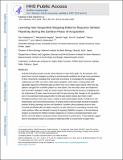| dc.contributor.author | Nakamura, Toru | |
| dc.contributor.author | Nagata, Masatoshi | |
| dc.contributor.author | Yagi, Takeshi | |
| dc.contributor.author | Graybiel, Ann M | |
| dc.contributor.author | Yamamori, Tetsuo | |
| dc.contributor.author | Kitsukawa, Takashi | |
| dc.date.accessioned | 2021-10-27T19:57:04Z | |
| dc.date.available | 2021-10-27T19:57:04Z | |
| dc.date.issued | 2017 | |
| dc.identifier.uri | https://hdl.handle.net/1721.1/133877 | |
| dc.description.abstract | © 2017 Federation of European Neuroscience Societies and John Wiley & Sons Ltd Animals including humans execute motor behavior to reach their goals. For this purpose, they must choose correct strategies according to environmental conditions and shape many parameters of their movements, including their serial order and timing. To investigate the neurobiology underlying such skills, we used a multi-sensor equipped, motor-driven running wheel with adjustable sequences of foothold pegs on which mice ran to obtain water reward. When the peg patterns changed from a familiar pattern to a new pattern, the mice had to learn and implement new locomotor strategies in order to receive reward. We found that the accuracy of stepping and the achievement of water reward improved with the new learning after changes in the peg-pattern, and c-Fos expression levels assayed after the first post-switch session were high in both dorsolateral striatum and motor cortex, relative to post-switch plateau levels. Combined in situ hybridization and immunohistochemistry of striatal sections demonstrated that both enkephalin-positive (indirect pathway) neurons and substance P-positive (direct pathway) neurons were recruited specifically after the pattern switches, as were interneurons expressing neuronal nitric oxide synthase. When we blocked N-methyl-D-aspartate (NMDA) receptors in the dorsolateral striatum by injecting the NMDA receptor antagonist, D-2-amino-5-phosphonopentanoic acid (AP5), we found delays in early post-switch improvement in performance. These findings suggest that the dorsolateral striatum is activated on detecting shifts in environment to adapt motor behavior to the new context via NMDA-dependent plasticity, and that this plasticity may underlie forming and breaking skills and habits as well as to behavioral difficulties in clinical disorders. | |
| dc.language.iso | en | |
| dc.publisher | Wiley | |
| dc.relation.isversionof | 10.1111/EJN.13537 | |
| dc.rights | Creative Commons Attribution-Noncommercial-Share Alike | |
| dc.rights.uri | http://creativecommons.org/licenses/by-nc-sa/4.0/ | |
| dc.source | PMC | |
| dc.title | Learning new sequential stepping patterns requires striatal plasticity during the earliest phase of acquisition | |
| dc.type | Article | |
| dc.identifier.citation | Nakamura, T., et al. "Learning New Sequential Stepping Patterns Requires Striatal Plasticity During the Earliest Phase of Acquisition." Eur J Neurosci 45 7 (2017): 901-11. | |
| dc.contributor.department | Massachusetts Institute of Technology. Department of Brain and Cognitive Sciences | |
| dc.contributor.department | McGovern Institute for Brain Research at MIT | |
| dc.relation.journal | European Journal of Neuroscience | |
| dc.eprint.version | Author's final manuscript | |
| dc.type.uri | http://purl.org/eprint/type/JournalArticle | |
| eprint.status | http://purl.org/eprint/status/PeerReviewed | |
| dc.date.updated | 2019-10-01T16:50:52Z | |
| dspace.orderedauthors | Nakamura, T; Nagata, M; Yagi, T; Graybiel, AM; Yamamori, T; Kitsukawa, T | |
| dspace.date.submission | 2019-10-01T16:50:55Z | |
| mit.journal.volume | 45 | |
| mit.journal.issue | 7 | |
| mit.metadata.status | Authority Work and Publication Information Needed | |
